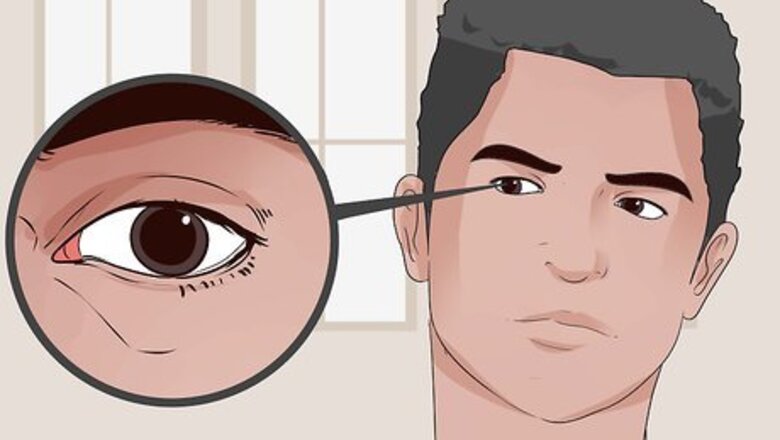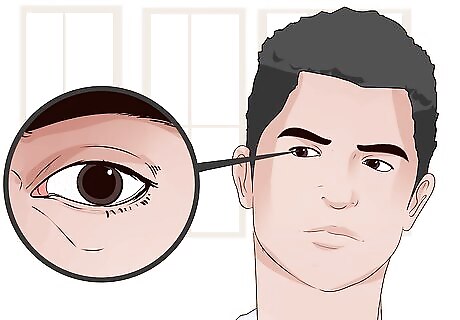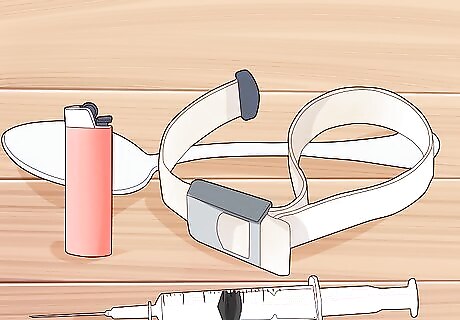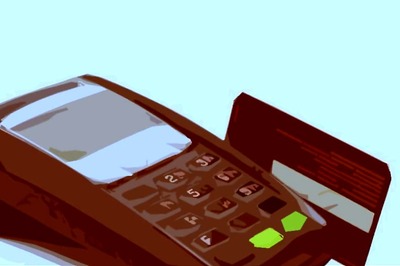
views
X
Research source
Cocaine is typically snorted through the nose but can be injected or smoked, and each method of administration carries its own risks of adverse effects.[2]
X
Research source
Learning the signs and symptoms of cocaine use can help you determine whether a friend or loved one is using cocaine, and help you determine how to intervene.
Recognizing Physical Indications of Cocaine Use

Check for dilated pupils. Cocaine use causes the pupils in the eyes to dilate because of the drug's stimulant effects. Look for widened pupils (the dark inner circle of the eye), even in well-lit rooms. Dilated pupils may or may not be accompanied by red, bloodshot eyes.

Look for signs of nasal stress. Because many users administer cocaine by snorting it through the nose, one of the telltale signs of cocaine use is nasal stress. Look for signs of: runny noses nosebleeds damage to the inside of nostrils difficulty swallowing a decreased sense of smell traces of white powder around the nostrils

Check for rapid pulse. Because cocaine is a stimulant, one of the common physical symptoms of cocaine use is a rapid heartbeat. In some cases, this may lead to cardiac arrhythmias (irregular heartbeat), hypertension, and cardiac death. A normal, healthy heart rate for most adults is between 60 and 100 beats per minute. Note that heart rate can be affected by other factors not associated with drug use, including physical activity, air temperature, body position, emotional states, and even certain legal medications. For this reason, heart rate alone should not necessarily be considered a definitive sign of drug use.

Recognize the signs of crack cocaine use. Another common method of administering cocaine is by smoking the drug, typically in the form of a solid "rock," called crack cocaine. Crack is formed by mixing powdered cocaine with water and baking soda. Signs of crack use include burned fingers or lips from lighting and smoking through a specialized device commonly called a crack pipe.

Identify the signs of intravenous drug use. Some users inject cocaine intravenously, using a syringe. This is done to experience immediate effects of the drug but comes with its own set of risks, including endocarditis (heart inflammation), cardiovascular disease, abscesses/infections, and an increased risk of overdose. Intravenous drug use also greatly increases the chances of transmitting a blood-borne disease like hepatitis and HIV. Signs of intravenous drug use include puncture marks (called "track marks"), most commonly seen in the arm, and possible skin infections or allergic reactions caused by additives mixed with cocaine.

Be aware of oral ingestion. One method of administering cocaine is by orally swallowing the drug. This produces fewer external signs of drug use than smoking, snorting, or injecting the drug, but it has been known to cause severe gangrene in the bowels and gastrointestinal tract due to reduced blood flow and GI sensitivity to the drug. In cases of oral ingestion, the most visible signs will probably be the symptoms typical of stimulant use, including: agitation unusual excitement hyperactivity suppressed appetite paranoia delusions
Looking for Behavioral Symptoms of Cocaine Use

Spot conversational clues. Cocaine and other stimulants often cause overly-energetic behavior. Common conversational clues of cocaine use include: excessive talkativeness rapid speech conversations that jump around from one topic to another

Look for risk-taking behavior. Cocaine use frequently gives users a sense of invincibility. This can lead to high-risk behavior, including risky sexual activities, and violent tendencies, such as fighting, domestic violence, homicide, and suicide. Risky sexual activities may lead to pregnancy, illness, and/or sexually transmitted infections. High-risk behavior may lead to legal problems, serious injury, or death.

Notice other behavioral changes. Someone who consistently uses cocaine may end up spending large amounts of time and energy acquiring cocaine. Users of cocaine may also engage in: shirking responsibilities or obligations frequently disappearing, going to the bathroom, or leaving the room, and returning in a different mood

Look for dramatic mood swings. Because cocaine is a stimulant, it can cause sudden changes in mood. This may mean irritability, but it could also cause sudden bursts of euphoria or a sense of carelessness, or a shift from one extreme to the other.

Notice social withdrawal. A common behavioral characteristic of people who use drugs is withdrawing from social relationships, either to be alone or to be with others who use drugs. Though socially withdrawing from a group of friends may be caused by other factors, such as anxiety or depression, it may also be a sign of drug use.

Note a loss of pleasure. Many users of all kinds of drugs experience a loss of pleasure in activities or interests that had previously been enjoyable, but this is particularly problematic with cocaine use. That's because cocaine use harms the circuits in the human brain that are responsible for a sense of pleasure. Look for signs of depression and a seeming lack of pleasure in day-to-day activities as a symptom of long-term cocaine use.
Spotting Evidence of Drug Use

Look for straws and tubes. Depending on the method of administration, there may be a wide range of cocaine-related paraphernalia. Because snorting cocaine is the most common method of ingestion, common paraphernalia items include: hollowed-out pens straws rolled up money or money that appears to have been rolled up razor blades, credit cards, or ID cards, often with powdery residue on the edges

Identify crack cocaine paraphernalia. Smoking cocaine typically requires a pipe, which may be made from glass or constructed out of aluminum foil. Look for: small glass pipes aluminum foil lighters empty plastic bags, including very small crack bags

Recognize evidence of intravenous drug use. Though less frequent than snorting or smoking the drug, intravenous injection of cocaine is still a common method of administration. Look for: syringes tourniquets, including belts and shoelaces spoons, which may have burn marks on the bottom lighters




















Comments
0 comment